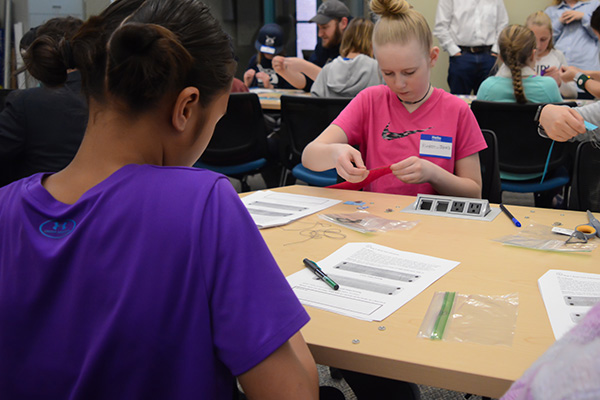Teal Students Practice Teaching the Wonders of Electricity

A class of fifth-graders from Edith Bowen Laboratory school got an up-close lesson on the wonders of electricity in a collaborative project with the School of Teacher Education and Leadership (TEAL).
The fifth-graders explored circuitry through several activities, learning how to sew bracelets that light up when snapped together. This hands-on activity is part of the secondary education curriculum in Dr. Colby Tofel-Grehl’s science teaching course.
University students in the course learn various methods of teaching science, and then put what they’ve learned into practice with the project. “It allows us to really distill their ability to teach these methods” Dr. Tofel-Grehl said.
The TEAL students work with children over the course of three weeks, teaching increasingly complicated material leading up to the bracelet activity. The university students rotate through different roles during the projects—working directly with the children; roaming the room, spotting potential confusion and stepping in; and observing their peers and taking notes.
Student teachers are often so focused on what they’re doing they miss the larger picture, Dr. Tofel-Grehl said. Viewing the overall classroom and watching their peers teach can help them see things from a different perspective and spot areas of improvement in their own teaching style.
Extending the project over multiple sessions also provides students with the opportunity to make corrections and immediately apply what they’ve learned in the classroom.
“At first, it’s kind of nerve-wracking, actually teaching children rather than just discussing how to teach them,” said Emily Olsen, one of Dr. Tofel-Grehl’s teaching assistants and a former student in the course. “It was helpful to implement the methods we learned about in class, talk about what worked and what didn’t, and then come back the next time and try to improve.”
University students aren’t the only ones who benefit from the activity. The children are introduced to simple scientific fundamentals and often change their perspectives on what a scientist is. Kids often imagine that a scientist looks like Albert Einstein, Dr. Tofel-Grehl said, but then they realize that they can be scientists too.
The idea of using bracelets to teach children about circuitry comes from Project Stitch, a learning resource devised by Dr. Tofel-Grehl and funded by a federal grant.
Dr. Tofel-Grehl’s took advantage of the interconnected nature of the College of Education and Human Services and by bringing in the class of fifth graders from the Edith Bowen Laboratory School to work with her student teachers.
“It’s so nice being at a place where we can work with the lab school and support those teachers at the same time,” Dr. Tofel-Grehl said.
The project serves as an example of the power of USU’s TEAL department. “Teacher education at Utah State does a good job of making sure students are practicing their skills, and that’s something that I’m very proud of,” Dr. Tofel-Grehl said. “This is a rich experience that the community gets to share, and as an institution, we value sharing and collaborating with the community.”

